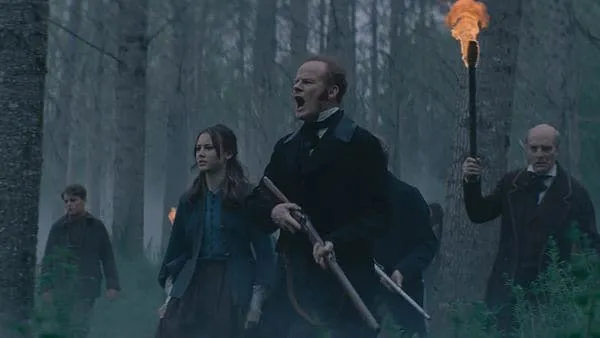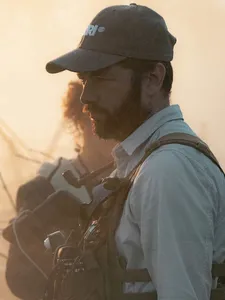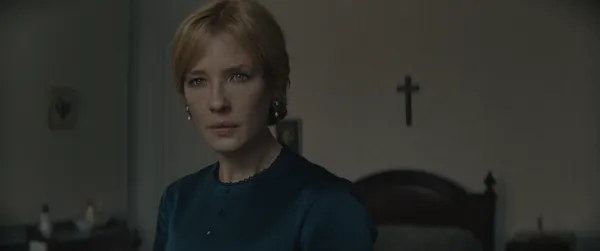 |
| Eight For Silver. Sean Ellis: 'I wasn't interested in making a film where someone sprouts teeth grows hair, and howls at the Moon' Photo: Courtesy of Sundance Institute |
Metro Manila and Anthropoid writer/director Sean Ellis steps back to the late-1800s for his latest film, Eight For Silver - now to be released in the US under new, sadly much more generic, title The Cursed - to reimagine the werewolf myth. The film, which had its world premiere at the Sundance Film Festival, sees a landowner (Alister Petrie) reap a Romany curse that leads to the disappearance of his son and the arrival of a pathologist (Boyd Holbrook), who aims to hunt the beast he believes is to blame. We caught up with Ellis over Zoom. Please note that this interview contains mild spoilers about the nature of the creature, so you may want to watch the film before reading on.
When people traditionally think of children’s nursery rhymes, it’s “six for silver”, tell us about the update
Sean Ellis: It was all to do with One for One for Sorrow, two for joy three for girl four for a boy. And then we went, “Five for wedding, six for birth, seven for a curse buried in the earth. Eight for silver nine for gold, 10 for a wolf, and you won't die old.” So actually, if you think about it, it’s the movie in a new nursery rhyme.
Speaking of the wolf, as we must, I'm interested in how you came by the idea, instead of having it sort of be a shapeshifting thing that were perhaps more used to with werewolves, basically, you went for more of a consumption idea - the werewolf sort of eating you up.
SE: I think saying that I was going to reinvent the werewolf genre was just too big a task. I honestly didn't know how to do it. And I wasn't interested in making a film where someone sprouts teeth grows hair, and howls at the Moon. I love An American Werewolf In London - when I watched it, it was one of my favourite films.
But now today, what can you do that kind of hasn't been done? And so I started to think more in terms of the original Wolf Man, being written by a Jewish writer, who wrote it as a metaphor for being Jewish in the 30s in Europe, and the fact that he was cursed, you know, being born into this religion, and being sort of hunted and chased for it, and persecuted for it. And, I thought that was so interesting, where real life mirrors art, or the other way around. And I started to think, in terms of what do we have in modern society that plagues us on a grand scale, and I started to about addiction. And whether it's addiction to drugs, or bad relationships, or your phone, or whatever it is, I think we've all experienced being a prisoner to our addictions. And so I started to think about the wolf as a metaphor for addiction.
 |
| Sean Ellis on being his own DP: 'You're very present for your actors, because you're obviously right behind the camera, you’re not behind a monitor somewhere in video village' Photo: Jacob Yakob |
That, basically, is where that idea of consumption comes from. Because it's not about you changing into something almost like it's kind of fun, like, “Oh, I'm going to be a wolf and I'm going to change into a werewolf”, it was actually something that you become a prisoner to. When I started to approach the material and the writing of the story with that in mind, that was when I started to get what I felt was a fresh approach to something that I knew, but I hadn't seen before. And so in a weird way, it was little steps like that, that enabled me to do the big change, and come up with a new concept.
It put me in mind a bit of a sort of, almost like a twist on a fairy tale in the sense that it's the Big Bad Wolf, but he's coming to eat you up in that way. And it taps into something perhaps a little bit primal for people.
SE: Exactly right. I think I think the thing is, I didn't think changing into a wolf was that scary. Is it that horrible that you're going to actually run around like an animal? But then I started to think what if, but what if you were trapped in it? And I started to think about how horrific that would be and all sorts of other things came out of that, like the sound design.
I feel like you're quite interested in this idea of doubles, you’ve had doppelgangers before in your films and I remember, you once told me that you thought The Two Faces Of Evil was a really scary movie when you were a kid? And I'm wondering if this is something that you kind of interested in this idea of, of people being able to become another thing, almost, but still retain something of themselves?
SE: I think we were all attracted to stories of horror and these stories that we tell each other as kids to scare each other, and I'm still interested in that, because I still think it's fascinating. It's a fascinating thing, being able to tell stories, and, and especially to actually feel an emotion from something that you're being told. So horror is an interesting genre in that sense, because it gives you such a wealth of different human experience in story form. And I guess this is just one that's a version of that experience. But like you said, primal - it's probably more akin to the stories that we used to tell around the campfire, when there were big predators.
You’ve always been a person who's got a real eye for visuals. And so having a creature the epitome of a great visual. How did you develop the idea and the look of the animal?
SE: A long, long research and development period, started with a conversation with [prosthetic make-up artist Mark Coulier, who had worked on Anthropoid with us and, and then he'd done kind of like, a model of what he thought it was, and based on my brief, and then we moved to Jean-Christophe Spadaccini [another special effects make-up artist], in Paris, who actually made a life-size version of the beast.
On set, we had three beasts - we had like an attack beast, we had a full animatronic beast, and we had like a stunt beast that we would throw at people, but it's just made of rubber.
We did the first part of the film in the winter of 2019, at the very beginning of the year, and then we edited through the summer. And then we looked at what we had, and we could see where it was weak. And you could see where its strengths were. And you could see, there was a lot of questions that still needed to be answered. I think the original script that we started filming on was probably only 60 to 70 pages and the idea was, we're always going to do it in two chunks because we were running out a winter. But then what happened is that, you know, once we sort of looked at what we had, then producers Pete Shilaimon and Mickey Liddell said, ‘Listen, I, we love this world, but how do we make it more? How do we go deeper? How do we how do we explain the Romanian gypsies a bit more and the curse of it.
 |
| Sean Ellis: 'I used to joke on set that at least I'll get to shoot Downton Abbey in the future' Photo: Courtesy LD Entertainment |
The ending originally wasn't very satisfying, but we didn't have time for the first part of the shoot to get a proper ending. So we came back, I think I wrote about another 2530 pages. And we came back to the beginning of 2020 and we did another 20 days filming. And that was a whole new end and a whole part of the beginning and quite a few other sort of scenes that we felt were needed, you know, scare scenes, and a bit more of taking what we knew and putting it in situations that we thought would be fun. And I that point, you could see that the beast was going need some kind of help, it looked a little bit stiff. We couldn't show it a lot.
I mean the film was sort of resembling Alien in some respect. You could use bits of it, but you couldn't really see all of it because it looked like a guy in a suit. At that point, we did a further design tweak, and then took that to CGV in Paris, and they basically started to work on top of what we had. But they could also show us stuff that we just couldn't physically get while we were shooting. And, and so that's where the CGI boys sort of stepped up and sort of took what we had and made what it what you see now.
It looks great, especially because of it being in a period context. We’re maybe not so used to seeing good monsters, if you like, in that sort of context, because a lot of classic older films obviously didn't have the power to do that. So it must have been quite exciting to be able to sort of incorporate something like that.
SE: It was really nice, because I used to joke on set that at least I'll get to shoot Downton Abbey in the future. I'll get my agent on to the producers tomorrow. But it was lovely to be able to mix, the two sort of genres, if you like, the period drama, because also I feel that I wanted the story to work without the beast. As a drama, it had to work and I wanted you to understand who these characters were, and they weren't just food for the for your CGI beast. They had to be real characters, there had to be real issues. And they had to make real decisions and be complex and, and interesting and have their own subplots that went on, that were nothing to do with what was happening, even though the main plot is something, like you say, is, is sort of to do with the original tradition of the genre of the werewolf. So it was it was really lovely to sort of try to meld those two genres and make them work together.
And you're still getting a kick out of shooting your own movies? You still haven’t had the urge to hand off the camera.
SE: You know, physically, it's getting more and more demanding. But I'm not getting any younger. I enjoyed the process on this one. I had a fantastic all French crew. I prefer it because there's less people on set. There's less people to talk to, there's les decisions to be made. So I mean, literally, it's like me, the producer, my gaffer and my grip, and we're the four.
You’re Covid-ready, already
SE: Yeah, put me in a bubble. But it means also, you're very present for your actors, because you're obviously right behind the camera, you’re not behind a monitor somewhere in video village. But the thing is, there's so many great DPs out there that I'd love to work with. So I would love to. I hope they would see I've been in their shoes. I have a much deeper understanding of what of what a director expects from them. And so I'll give them the time to create what it is that we need to create. Whereas I think most DPs are not given that time - they've barely got a metre reading before the cameras rolling.
The film looks lovely, the mist scenes are terrific. And who would have thought, flaming horses? Were they just CGI or how did you do that?
Yeah, that was an interesting one. They were practical. There are two practical horses with riders and the riders were covered with LED lamps. So they were basically shining light off the vest onto the horse and onto the floor. So as the horse ran, their legs make contact with the floor and the shadow and the light actually did the thing for us. Then digitally, the riders were removed and the flames were added. But because the light that was originally there matches the flame, it sits perfectly.
The Cursed - formerly Eight For Silver - will be released in US cinemas on February 18





















